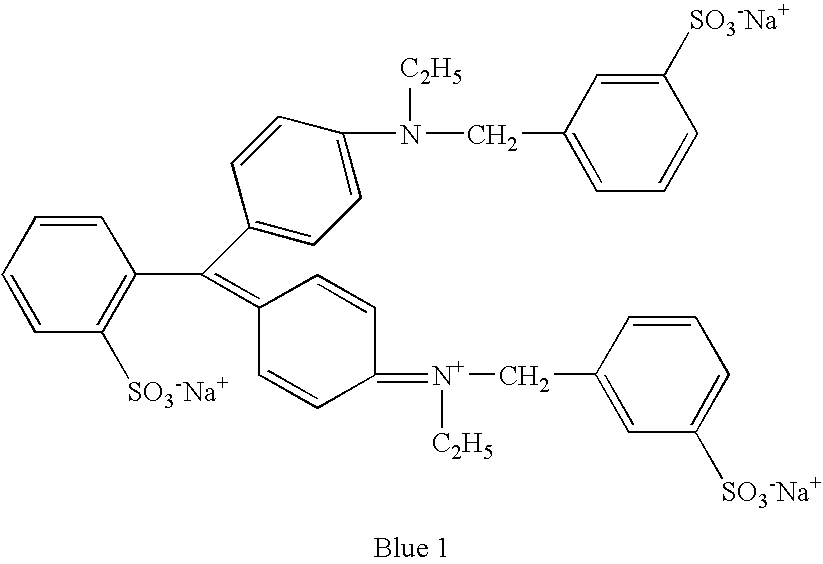Bacteria capturing treatment for fibrous webs
a fibrous web and bacteria technology, applied in the direction of biocide, non-ionic surface active compounds, detergent compounding agents, etc., can solve the problem that pathogens, such as bacteria, are susceptible to electrostatic attraction to oppositely charged molecules
- Summary
- Abstract
- Description
- Claims
- Application Information
AI Technical Summary
Problems solved by technology
Method used
Image
Examples
example 1
Determining the Anionic Attraction Ability of Treated Webs
[0043] Samples of spunbond / meltblown / spunbond (SMS) material were prepared by cutting a surgical gown sold under the trade name Control* cover gown (having a basis weight of 1.0 osy) by Kimberly Clark Corp. of Neenah, Wis. The SMS laminate has a polypropylene meltblown web sandwiched between two exterior polypropylene spunbond webs.
[0044] The SMS substrate was wet with an aqueous solution containing 20% by weight sodium dodecyl sulfate (SDS). The surfactant solution immediately wet the SMS substrate. The sodium dodecyl sulfate solution was allowed to saturate the SMS substrate.
[0045] Then, an aqueous solution containing 50% by weight aluminum chlorohydrate was added to the already saturated and still wet SMS substrate. A precipitate immediately formed where the aluminum chlorohydrate solution was applied to the surfactant-soaked SMS substrate. The combined solutions and resulting precipitate were agitated and mixed by hand...
example 2
Optimizing the Concentrations of the Treatment Solutions
[0051] To determine what levels of loading were necessary to capture the entire 5 μL of the dye solution that is added to the SMS material, the following was performed.
Determination of the Optimal Concentration of the Aluminum Salt Solution:
[0052] Several SMS substrates, as described in Example 1, were wet with an aqueous solution containing 20 wt % sodium dodecyl sulfate. Then, the an aqueous solution containing aluminum chlorohydrate was added to each SMS substrate, allowed to precipitate out the aluminum surfactant, worked into the SMS substrate, rinsed well with water, and allowed to dry. The concentrations of the aqueous solutions containing the aluminum chlorohydrate were as follows:
50 wt %
25 wt %
10 wt %.
5 wt %
1 wt %.
[0053] Once dried each of the treated substrates were tested using the dye solution of Example 1. The substrates treated with the 50 wt % and the 25 wt % aluminum chlorohydrate solutions both b...
example 3
Treating SMS Laminate with Aluminium Chlorohydrate
[0057] For coating the substrates a 500 ml aqueous formulation is prepared containing 1.0 wt % alumina oligomer +99.0 wt % water / Hexanol.
[0058] A 1 wt % aluminium chlorohydrate solution was prepared by diluting a stock aluminium chlorohydrate (supplied from GEO Specialty Chemicals located in Little Rock, Ark.) solution (50 wt % solution in water, 10 mL) with de-ionized water (485 mL) and hexanol (5 ml) mixture.
[0059] An SMS untreated substrate with size of 8″×12″ was cut from a surgical gown sold under the trade name Control* cover gown (having a basis weight of 1.0 osy) by Kimberly Clark Corp. of Neenah, Wis. The SMS laminate has a meltblown web sandwiched between two exterior spunbond webs.
[0060] Treatment of the SMS substrate entailed a “dip and squeeze” protocol. Each substrate was weighed first (Wbefore) and submerged in the 1 wt % alumina oligomer solution and agitated for approximately 1 min to ensure saturation. The treat...
PUM
| Property | Measurement | Unit |
|---|---|---|
| diameter | aaaaa | aaaaa |
| diameters | aaaaa | aaaaa |
| diameters | aaaaa | aaaaa |
Abstract
Description
Claims
Application Information
 Login to View More
Login to View More - R&D
- Intellectual Property
- Life Sciences
- Materials
- Tech Scout
- Unparalleled Data Quality
- Higher Quality Content
- 60% Fewer Hallucinations
Browse by: Latest US Patents, China's latest patents, Technical Efficacy Thesaurus, Application Domain, Technology Topic, Popular Technical Reports.
© 2025 PatSnap. All rights reserved.Legal|Privacy policy|Modern Slavery Act Transparency Statement|Sitemap|About US| Contact US: help@patsnap.com

